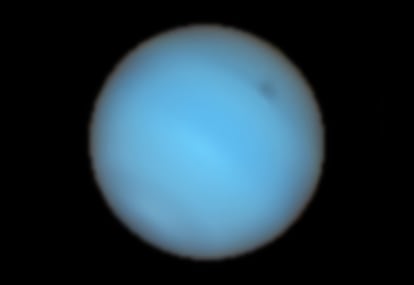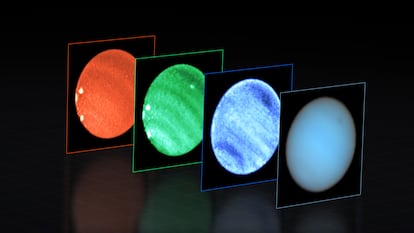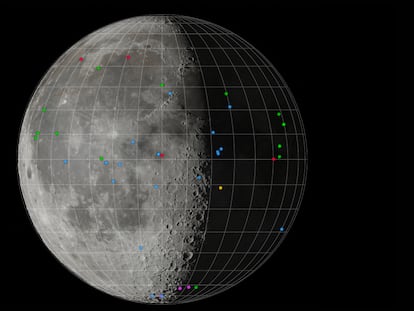Mysterious dark spot on Neptune captured in an image from Earth for the first time
The Very Large Telescope, located in the Atacama Desert in Chile, detected this large black spot, the nature and origin of which remain unknown

Dark spots have been observed on Neptune for more than 30 years. These planetary-scale vortices, similar in scale to the Earth, appear and disappear on the icy giant. Beyond what can be observed in the atmosphere, the nature of the spots is unknown. To delve deeper into this cosmic mystery, an international consortium studied the phenomenon from a ground-based telescope, the first to capture and analyze the large dark spot. The results were published today in the scientific journal Nature Astronomy.
Thanks to the Very Large Telescope (VLT), the group led by Patrick Irwin, a professor at the University of Oxford in the United Kingdom, identified aerosols (any solid or liquid particle that interferes with sunlight) as the cause of the darkening in the nebular formation, as compared to the normal bluish background of Neptune’s atmosphere. In the article, Irwin’s team writes that they were able to analyze the sunlight reflected by the planet at different wavelengths, allowing them to determine the height at which the spot is located, and the nature of its darkening as compared to the rest of the atmosphere. They achieved all of this by using the European Southern Observatory’s MUSE instrument, situated on a hill in Chile’s Atacama Desert, where the VLT is located.
The study of Neptune’s outer atmosphere points to the presence of hazes, methane ice clouds and, at greater depths, hydrogen sulfide. “Below the hydrogen sulfide clouds, the models also indicate the presence of ammonium hydrosulfide or water clouds, but in the absence of observations at such depths. the presence of the latter could not be confirmed yet,” says co-author Daniel Toledo. According to the National Institute for Aerospace Technology (INTA; Spain) physicist, the most important aspect of this work is the understanding that a change in the nature of the aerosols at the planet’s depth produced the dark spot on Neptune, not a clearing between storm clouds at those heights.

During their space travels, the Voyager 2 probe in 1989 and the Hubble telescope in 1996 took snapshots of different large intermittent spots on Neptune. These photographs were useful in determining the size and shape of the phenomena, “basically an external description of the vortices,” says Toledo. But to find out its composition, scientists required the use of the VLT’s MUSE instrument, which can conduct an analysis of the “complete spectrum of the vortex in many wavelengths” through spectrographic techniques. Surprisingly, “from a certain wavelength, at 700 nanometers, [the dark spot] disappears,” says the physicist, describing the three-dimensional model of the results of his research.
“Because of the variation in the absorption of methane gas by wavelength, we can establish the depths from which we are observing the light reflected by the atmosphere,” the INTA scientist explains. That indicates that the observed phenomenon occurs in the upper parts of the icy planet’s atmosphere, at pressure levels of 4–5 bars, which is below the condensation level of the methane clouds seen in the classic photographs of Neptune. Toledo draws a terrestrial parallel: “The same thing happens on Earth with ultraviolet light, which is mostly absorbed in the stratosphere by ozone. So, if we observe the Earth from outside its atmosphere, the light reflected in ultraviolet results from interactions between sunlight and the atmosphere at altitudes above the ozone layer.”
In visible light, Neptune appears blue due to small amounts of methane gas in its atmosphere. Webb’s NIRCam instrument instead observed Neptune at near-infrared wavelengths, so Neptune doesn’t look so blue! pic.twitter.com/aZZa8B8x4f
— NASA Webb Telescope (@NASAWebb) September 21, 2022
While cognizant of the limitations of the study, which focuses on the outer layer of the planet, Toledo is pleased “to know that the dark spot is the result of an atmospheric phenomenon that is occurring at depths where our knowledge is very limited due to a lack of direct observation.” The article itself explains that the causes of the movement within the large spot are still unknown, although the scientists theorize that “it could be related to the photolysis of certain gases” in the giant planet.
Researchers Irwin and Toledo emphasize that they can obtain an image with a great deal of information about the solar system’s seventh planet from Earth. But the co-investigator notes that future research will require space probes to go beyond the limits of current models: “Logically, the next step would have to be a mission dedicated to these planets [Uranus or Neptune], since the ice giants are the only planets in the solar system that have not had a mission focused on them.” Toledo says that sending probes will be a “top priority” for NASA in the coming years, because of the knowledge that these natural satellites can offer about the solar system’s origin; they also aid space exploration because of their similarity with the exoplanets studied in the Milky Way.
Sign up for our weekly newsletter to get more English-language news coverage from EL PAÍS USA Edition
Tu suscripción se está usando en otro dispositivo
¿Quieres añadir otro usuario a tu suscripción?
Si continúas leyendo en este dispositivo, no se podrá leer en el otro.
FlechaTu suscripción se está usando en otro dispositivo y solo puedes acceder a EL PAÍS desde un dispositivo a la vez.
Si quieres compartir tu cuenta, cambia tu suscripción a la modalidad Premium, así podrás añadir otro usuario. Cada uno accederá con su propia cuenta de email, lo que os permitirá personalizar vuestra experiencia en EL PAÍS.
¿Tienes una suscripción de empresa? Accede aquí para contratar más cuentas.
En el caso de no saber quién está usando tu cuenta, te recomendamos cambiar tu contraseña aquí.
Si decides continuar compartiendo tu cuenta, este mensaje se mostrará en tu dispositivo y en el de la otra persona que está usando tu cuenta de forma indefinida, afectando a tu experiencia de lectura. Puedes consultar aquí los términos y condiciones de la suscripción digital.
More information
Archived In
Últimas noticias
Mustafa Suleyman: ‘Controlling AI is the challenge of our time’
Venezuela breaks energy agreements with Trinidad and Tobago due to alleged complicity with the US
The murder of Michele and Rob Reiner: A tale of horrific days in Hollywood
Trump orders a ‘complete blockade of sanctioned oil tankers’ going to and from Venezuela
Most viewed
- ‘El Limones’ and the growing union disguise of Mexican organized crime
- Christian Louboutin: ‘Young people don’t want to be like their parents. And if their parents wear sneakers, they’re going to look for something else’
- ‘We are dying’: Cuba sinks into a health crisis amid medicine shortages and misdiagnosis
- A mountaineer, accused of manslaughter for the death of his partner during a climb: He silenced his phone and refused a helicopter rescue
- The low-cost creative revolution: How technology is making art accessible to everyone










































